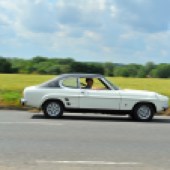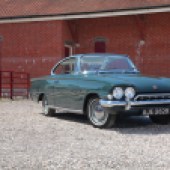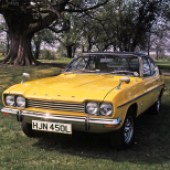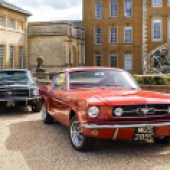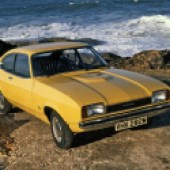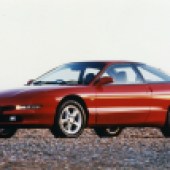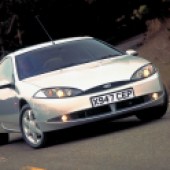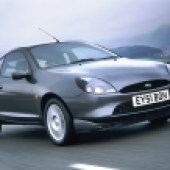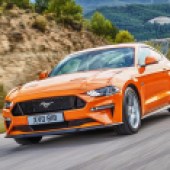British buyers have been treated to a wide array of stylish Ford coupes over the last half a century, some of which have gone on to gain a cult following of their own. Paul Guinness takes a look at this extensive line-up…
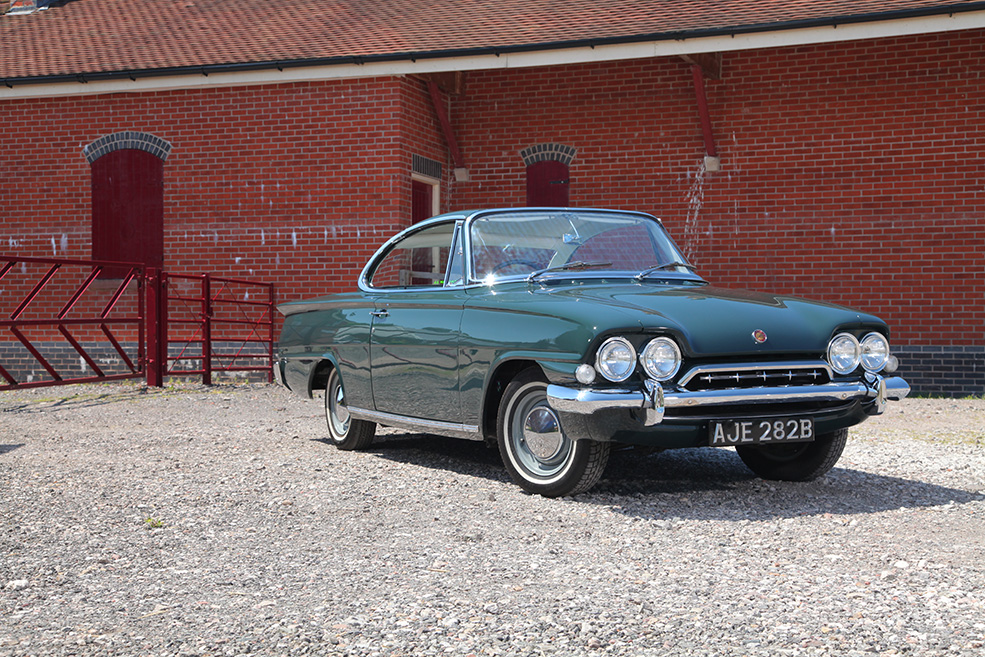
FORD CONSUL CAPRI
Although the new-for-1969 Ford Capri (the model that marked the start of a long and successful line of Ford coupes here in Britain) is now best-known as the MkI, it wasn’t the first car to carry the illustrious Capri moniker. In fact, that honour went to the stylish new Ford Consul Capri of 1961.
Based on the Consul Classic saloon launched the same year, the Consul Capri shared essentially the same bodyshell but with a stylish coupe roofline in place of the Classic’s reverse-rake back window. It was a clever transformation, giving the Consul Capri a pleasingly sporty look and providing Ford with an attention-grabbing coupe.
Sadly, though, the Consul Capri wasn’t a great success, finally fading away from the showrooms in 1964 after total sales of just 19,000 cars. With a track record like that, perhaps it’s not surprising that it took Ford of Britain another five years to re-join the sporting coupe scene.

FORD MUSTANG
The original Mustang of 1964 was Ford of America’s first ‘pony car’, a model designed from the outset to be compact, stylish and affordable – but with a distinctly sporting twist. It was something that an American manufacturer had never tried before, not least because that home market was renowned for its love of V8-engined behemoths. So investing in the development of a compact coupe that went against traditional values was surely a risky business?
Ford needn’t have worried, because the Mustang went on to be a huge success; the first-generation model stayed around (via various upgrades) for ten years, eventually replaced by the short-lived Mustang II in 1974. The Mustang theme was then developed through further redesigns and relaunches, ending up with the sixth-generation model (covered further on) that we have today.
Previous-generation Mustangs were niche offerings here in the UK, where small-scale imports and specialist dealerships just about kept the model alive. But among Britain’s army of American car enthusiasts, it remained (and still does) a popular choice, with no shortage of first-gen versions still being personally imported from the USA.

FORD CAPRI MkI
The concept behind the Capri was refreshingly straightforward, following in the footsteps of Ford of America’s top-selling ‘pony car’. The new Capri would use existing components from elsewhere within the European Ford line-up (including a floorpan based around that of the Cortina), all surrounded by sporty, low-slung styling. The new Capri’s 1298cc engine came straight from the MkI Escort, the 1599cc lump from the Cortina and the 2.0-litre from the Corsair, with power transferred via an ex-Cortina gearbox in each case.
Capri production got under way at Halewood in November 1968 ready for the car’s official unveiling at the following January’s Brussels Motor Show – and, not surprisingly, Ford’s first European-market coupe in many a year caused a sensation. The response was particularly strong here in the UK, which would go on to become the world’s longest-served Capri market. Much of the Capri’s success was down to the sheer variety of different versions that were available; but it was when the 3.0-litre V6-engined Capri hit the market that Ford of Britain finally had its own ‘muscle coupe’ on offer, with 138bhp at its disposal.
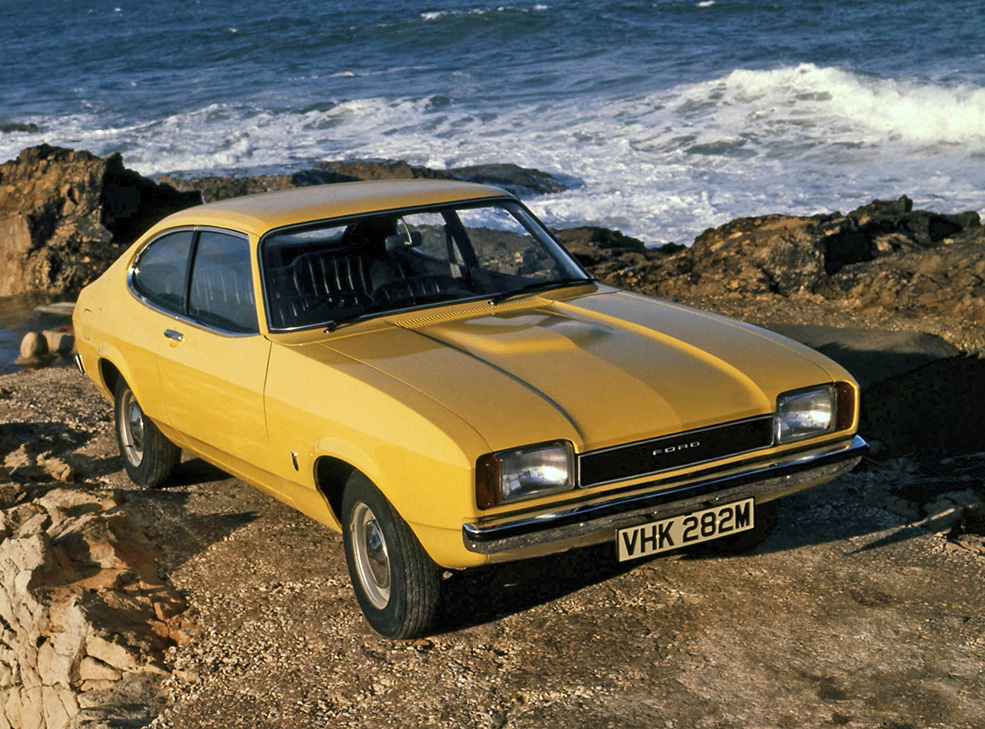
FORD CAPRI MkII
Based around the floorpan of its predecessor, the MkII of 1974 offered completely new styling and a fresher image, albeit with various Capri cues included – such as the all-important half-oval rear side windows, the gently sloping rear and the seemingly never-ending bonnet. Biggest change was at the back, however, where a full-size tailgate replaced the MkI’s conventional boot lid, transforming the Capri into a versatile but still sporting hatchback.
The MkII Capri was, of course, still a decent driver’s car, particularly in larger-engined guises; and once the 3.0S arrived in 1975, complete with beefed-up suspension, cracking performance and super-sharp handling, the Capri’s reputation moved up yet another notch.
With the almost inevitable choice of 1.3, 1.6, 2.0 and 3.0-litre engines in the UK, there was once again a Capri for every buyer. No surprise then, that the MkII proved to be phenomenally successful, with well over 400,000 cars sold despite it having the shortest production run of all the Capri variants.
FORD CAPRI MkIII
When Ford unveiled its new MkIII Capri line-up in March 1978, it generated plenty of excitement – which was quite an achievement, because in reality the MkIII was little more than a frontal restyle of the hatchback-model MkII. And yet the difference made by this fairly simple piece of engineering was amazing.
New front wings, a longer bonnet, modern grille and quad round headlamps were grafted on (together with bigger rear lights), giving the MkIII a surprisingly fresh look. Engine options continued as before, with the initial MkIII line-up comprising 1.3, 1.6 and 2.0-litre four-cylinder offerings, plus the good old Essex 3.0-litre V6. As the Eighties beckoned, however, it was obvious that the Capri couldn’t afford to rest on its laurels – and the result was the 1981 Capri 2.8 Injection, the first product from Ford’s new Special Vehicle Engineering division.
The transformation was impressive, with the 160bhp Cologne engine endowing the classic coupe with superb figures for the time, thanks to a top speed of 127mph and the crucial 0-60mph dash in a mere 7.8 seconds.
The 2.8i was replaced by the Injection Special in 1984, complete with half-leather interior and limited-slip rear differential. This was the most sophisticated Capri ever launched and succeeded in helping to keep the name alive for a while longer, aided by the subsequent Capri 280 Brooklands – of which just 1038 were produced, all for the UK market. The end was nigh, however, and the very last Capri finally rolled off the line just before Christmas 1986.
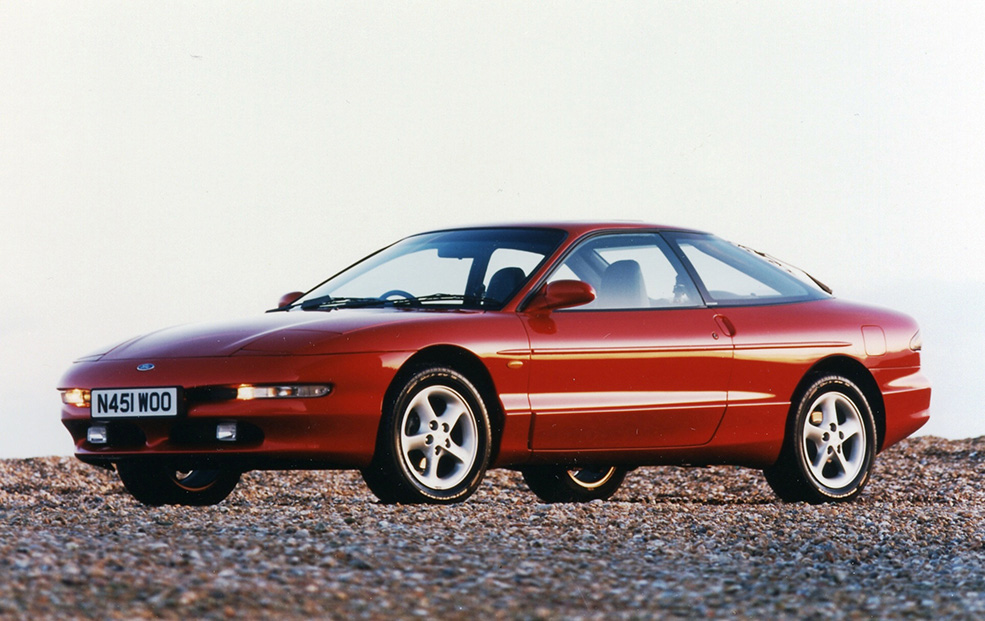
FORD PROBE
The death of the Capri in December 1986 left Ford without a coupe, a gap in its range that wasn’t filled in the UK until the arrival of the US-built Probe seven years later. American buyers had already seen a Probe on sale, with the first-generation model of 1989-92 being co-developed with Mazda. But the MkII was the one for which Ford saw potential in Europe, particularly in Britain, where sales of 2+2 coupes were booming by the early Nineties.
The latest Probe was again a joint Mazda/Ford development, with the Japanese firm also supplying its 2.0-litre four-cylinder and 2.5-litre V6 engines. Testers weren’t overly impressed with its driving style when it went on sale here in 1994, with its relatively soft suspension making it more of a long-distance cruiser than a top-handling sportster. But there was nothing wrong with the performance of the V6 in particular, with its 165bhp output providing a top speed of 134mph, with 60mph from rest in just 7.9 seconds. UK sales remained lacklustre, however, and by the end of 1997 the Probe was quietly dropped from the range as Ford fans awaited the arrival of its Cougar successor.
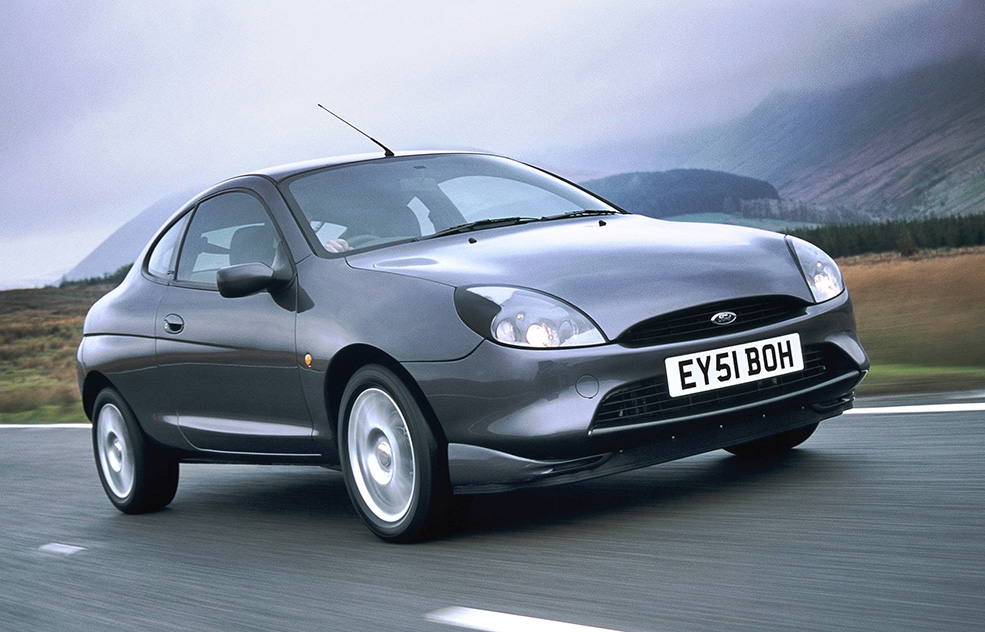
FORD PUMA
Making its debut in 1997 was the Puma, an additional model to the Ford line-up as well as its most compact coupe to date – one that soon developed a reputation for sheer entertainment value. It might have been based around the fairly unexciting MkIV Fiesta of the time, but that at least meant a platform renowned for its handling ability. Throw into the mix a choice of 16-valve powerplants (of 1.4 to 1.7-litre capacity, developing 90-123bhp) and you had the perfect recipe for some behind-the-wheel fun.
Those might not sound like exciting outputs, but in a car that was relatively lightweight and which boasted tenacious grip, it was easy to enjoy yourself. Anyone who managed to pilot a Puma along their favourite twisting A-road soon realised just how competent it was, so sharp was its handling and steering. It sold well too, appealing to drivers looking for something a bit more stylish than a supermini-based hot hatch; and yet the Puma was destined for a relatively short life, with the final example rolling off its German production line as early as July 2002.

FORD COUGAR
Announced in 1998 was the long-awaited Cougar, replacement for the slow-selling Probe and the latest car to feature Ford’s ‘New Edge’ styling, following in the tyre tracks of the Ka, Puma and Focus. Unlike the Probe, the Cougar was an all-Ford design, this time based around the Mondeo platform of the time.
The Cougar came with a choice of two different engines, with the entry-level 1998cc Zetec four-cylinder unit pushing out 129bhp compared with the rather more impressive 168bhp of its 2544cc Duratec V6 alternative. The latter offered a top speed of 140mph, with 0-60 in around 7.5 seconds, all set against a terrific aural backdrop; but even the smaller-engined Cougar managed to offer decent performance and a far more engaging driving experience than the car it replaced.
Despite an expensive marketing campaign (anyone remember the TV ad featuring Dennis Hopper?), the Cougar was something of a flop by Ford standards, with annual UK sales struggling to get above the 5-6000 mark. British imports ceased in 2001, although the Cougar remained on sale in the rest of Europe through to the following year.
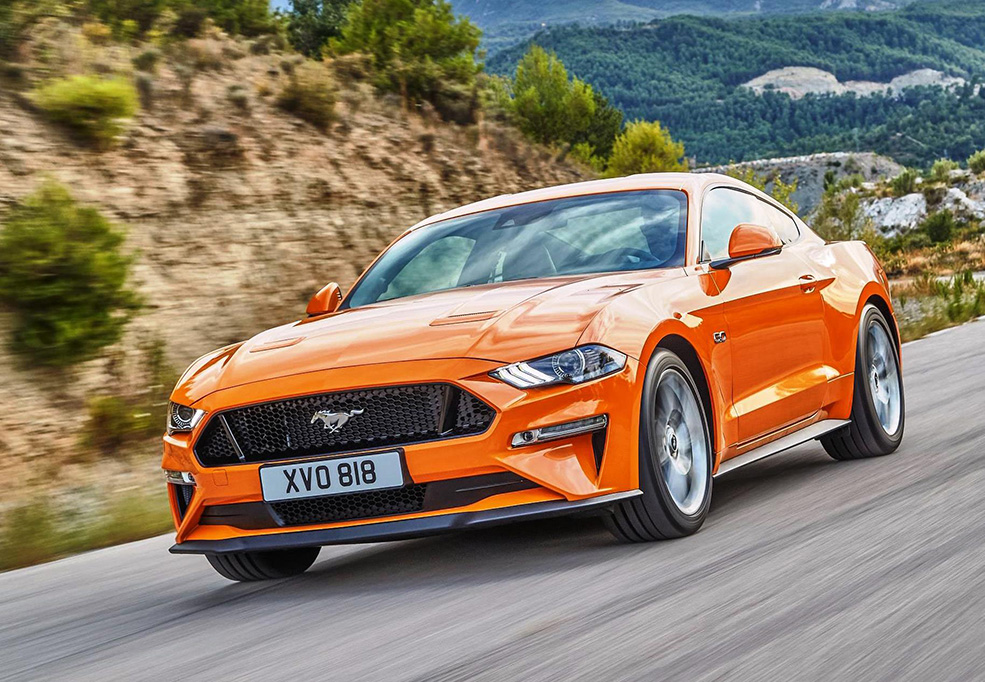
MODERN-DAY MUSTANG
When it comes to UK sales, Ford coupes have experienced some real extremes. Models as disparate as the Consul Capri of the early Sixties and the Cougar of the late Nineties were notable for their poor sales volumes, and yet the three generations of 1969-86 Capri proved to be astonishingly successful. So where does that leave Ford as we head towards 2018? Pretty much back where it started, actually… but in a good way.
Today’s Ford coupe is the sixth-generation Mustang, which entered production in 2014 as the most advanced model to date, featuring fully-independent rear suspension and an intriguing range of engines. More important, however, was the fact that this Mustang was the first to be designed for an international audience, with right-hand drive included in the plans from day one – and official UK sales as a result.
Today’s British Mustang buyers have a choice of 2.3-litre four-cylinder ‘Ecoboost’ or 5.0-litre V8 engines (the latter developing well over 400bhp), with list prices starting from £33,645. And the good news is that the Mustang is proving extremely popular, with healthy sales figures throughout Europe.
The Capri might have died almost exactly 31 years ago, but the ‘pony’ car’ that inspired it is doing rather well for itself in its latest incarnation – especially here in Britain. For Ford fans around the UK, that has to be excellent news.


